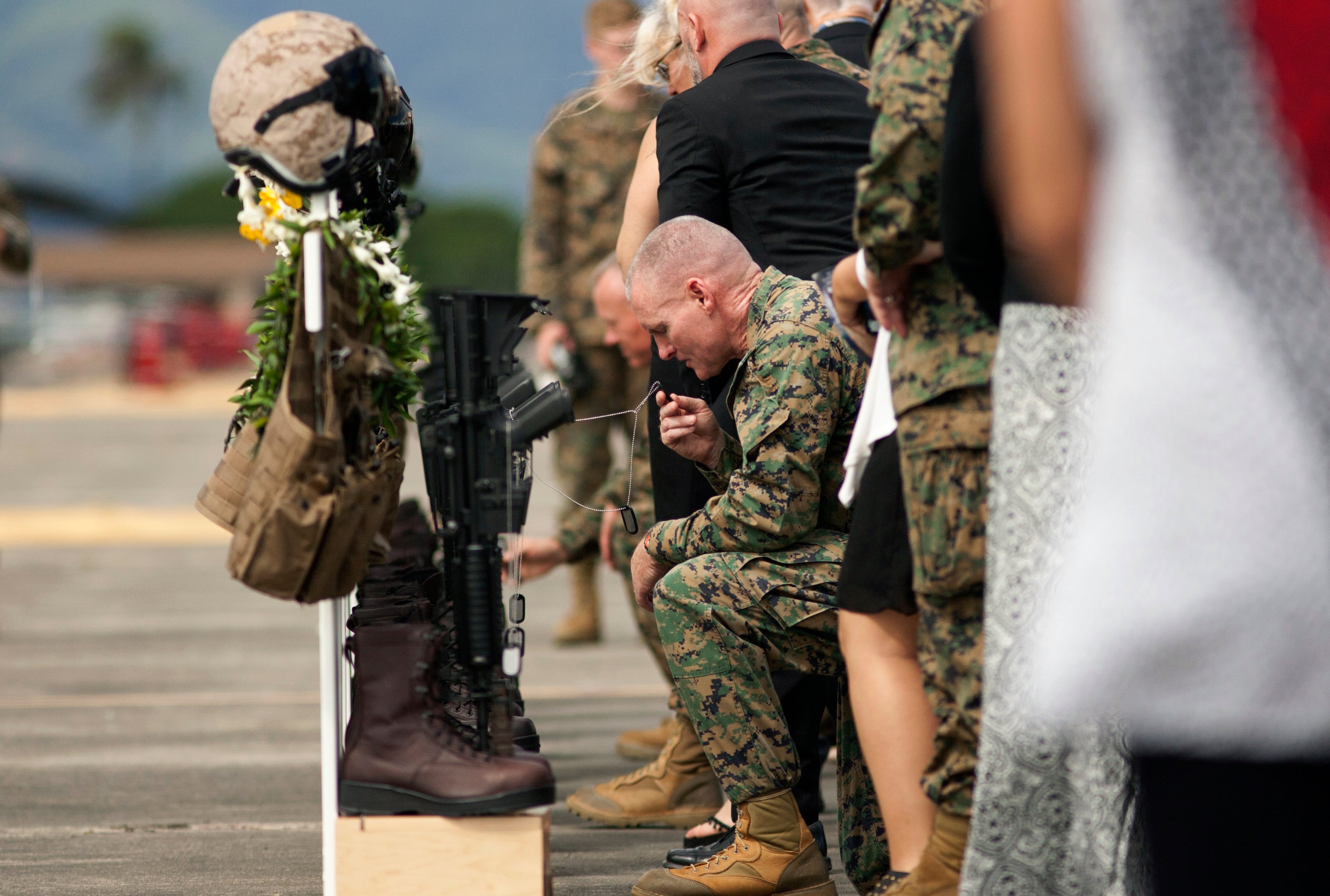The Marine helicopter squadron that suffered the service's deadliest aviation accident in 2016 was in crisis months before two of its CH-53 Super Stallions crashed during a Jan. 14 nighttime mission off Hawaii, according to a new investigation.
The immediate cause of the mid-air collision between the two helicopters with Marine Heavy Helicopter Squadron 463 was "pilot error," an official said, in the crash that took the lives of all 12 Marines aboard both aircraft.
"Low light conditions made it difficult for the aircrew to recognize the rapid decrease in separation between the aircraft which led to the collision," said Lt. Col. Curtis Hill, a spokesman for U.S. Marine Corps Forces Pacific.
However, the underlying causes of the crash reveal the squadron suffered from severe readiness problems like flight hours and parts shortfalls that are endemic to Marine Corps aviation — especially the troubled CH-53E fleet.
The squadron did not have enough helicopters that could fly; crews were not getting enough flying hours; morale was low and crews were battling fatigue; according to a redacted version of the new Marine Corps report released Thursday.
Without enough flyable aircraft, the squadron was about 606 hours behind on its scheduled flight hours for fiscal 2016 by January, the investigation says. Pilots feared the low number of working aircraft was causing their skills to atrophy.
"In December 2015, copilots complained that during that year, although they were supposed to log 16 hours each month, they were lucky to log 10 hours," the investigation found. "By January 2016, many pilots in HMH-463 believed they were not ready for combat as they felt they would not be able to safely execute certain tasks, like safely landing a helicopter at night, because they were not logging enough flight training hours."
As of July 31, each CH-53 squadron had an average of 5.3 flyable aircraft out of a total of 16 helicopters, said Marine Corps spokeswoman Capt. Sarah Burns.
HMH-463's issues reflect wider problems with the Marine Corps' aging CH-53E, a heavy-lift cargo and personnel carrier that can haul as much as 32,000 pounds. A 2015 study found that readiness levels for Super Stallions Corps-wide were "appalling," in part due to a lack of aircraft, resources, training and the fact that there was no reset after the wars in Iraq and Afghanistan, the investigation found.
Getting spare parts for CH-53Es can take a while because the helicopter is out of production, causing the Marine Corps to manufacture some replacement parts for the aircraft, John Olmstead, a spokesman for Fleet Readiness Center East at Cherry Point, North Carolina, told Marine Corps Times in April.
The investigation into the crash found that HMH-463 struggled to keep its helicopters flying, ultimately leading squadron commander Lt. Col. Edward Pavelka to be fired three days before the crash.
HMH-463 failed an inspection in September 2015, the investigation says. When the squadron was unable to get 50 percent of its helicopters flyable by Thanksgiving, crews were ordered to work "12 hours on, 12 hours off," but there were days in December when no helicopters were able to fly.
"Most members of HMH-463 did not see any end in sight with regard to the long working hours. They claim this led to low morale and cumulative fatigue throughout HMH-463," the investigation says.
On Jan. 11, Brig. Gen. Russell Sanborn, commander of the 1
Marine Aircraft Wing, fired Pavelka "because of a loss of confidence stemming primarily from inadequate improvement in HMH-463 aircraft readiness rates from the time of the failed inspection in September 2015 through the first days of 2016," the investigation found.
One source, whose name was redacted from the report, told investigators that Pavelka warned Sanborn that his relief would put Marines’ lives at risk: "He said, ‘If the General wants up aircraft, the Marines will get him up aircraft,’ implying that readiness reporting would become inflated and corrupted," the investigation says.
Sanborn disputed that he was told Pavelka’s firing would jeopardize Marines’ safety, according to the investigation.
CH-53E Super Stallions have the most serious readiness problems of any Marine Corps aircraft, the head of Marine aviation said in September. In fiscal 2015, an average of 44 out of the Marine Corps’ 146 CH-53Es were flyable, according to the investigation.
"Although readiness had increased from earlier in the year, the fleet still was only 31 percent to standard," the investigation says. "The goal set by the Marine Corps Deputy Commandant for Aviation for HMH squadrons that fiscal year was 56 RBA, while actual RBA was 37.2."
CH-53Es have the "highest cannibalization rate" of any Marine helicopters, according to the investigation. Crews in HMH-463 had to take parts from other aircraft in Hawaii to send enough CH-53Es to Australia for the 2015 Marine Rotational Force-Darwin.
"Many of the Marines who deployed to Australia in 2015 dreaded coming back to Hawaii because of the long working hours and low morale," the investigation says, "Between the failed maintenance inspection in September 2015 and the mishap flight on 14 January 2016, HMH-463 Marines worked long hours, often including weekends, and experienced the effects of long-term, cumulative fatigue."
As of September, about 27 percent of Marine Corps CH-53Es could not fly because they needed spare parts, said Lt. Gen. Jon Davis, deputy commandant for aviation.
The Marine Corps plans to repair all 146 of its CH-53Es over the next three years, during which 16 helicopters will be refurbished every 110 days, Davis told Marine Corps Times in a Sept. 6 interview. Ultimately, the service plans to replace its CH-53Es with 200 new CH-53Ks between 2019 and 2029.
The Marine Corps has asked Congress for more money to accelerate the purchase of other aircraft, but the time line for fielding the CH-53K has not changed, officials said.




